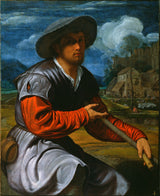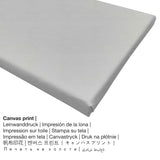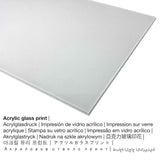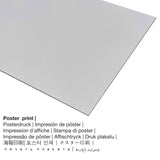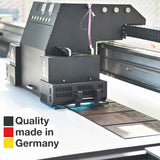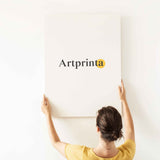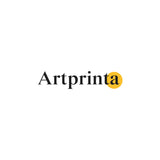Girolamo Savoldo, 1525 - Onye ọzụzụ atụrụ nwere ọjà - mbipụta nka mara mma
Ụtụ gụnyere. Mbupu gbakọrọ na ndenye ọpụpụ.
Ozi zuru ezu na ngwaahịa nka
The more than 490 year-old piece of art was made by the artist Girolamo Savoldo in 1525. Nke mbụ nwere nha ndị a: 97 x 77,9 cm (38 3/16 x 30 11/16 na) e were kwa ihe-ọcha tee ya mmanụ na kwaaji. E wezụga nke ahụ, mpempe nka dị na nchịkọta nka dijitalụ nke Ụlọ ihe ngosi nka nke J. Paul Getty emi odude ke Los Angeles, California, Njikota Obodo Amerika. Site n'ikike nke: The J. Paul Getty Museum (ikike - ngalaba ọha).Ebe E Si Nweta nke ihe osise:. Na mgbakwunye na nke a, nhazi nke mmepụta dijitalụ bụ Eserese na nwere akụkụ ruru nke 1: 1.2, nke pụtara na ogologo bụ 20% mkpụmkpụ karịa obosara.
Akụrụngwa ndị ahịa anyị nwere ike iburu
In the dropdown menu next to the product you can choose your prefered size and material. We allow yout to choose among the following variants:
- Aluminom dibond mbipụta (ọla): An Aluminium Dibond print is a print material with a true depth effect. A non-reflective surface structure make a contemporary impression. A direct Aluminium Dibond Print is the ideal introduction to reproductions with aluminum. For the Direct Aluminium Dibond option, we print the selected work of art right on the surface of the white-primed aluminum material. The bright parts of the artwork shimmer with a silky gloss but without the glare. The colors are luminous in the highest definition, details of the print are crisp, and you can perceive the matte appearance of the surface.
- Mbipụta kanvas: The UV printed canvas applied on a wooden frame. It makes the typical effect of three dimensionality. Your printed canvas of this artpiece will allow you to transform your own into a large size artpiece. Canvas Prints have the great advantage of being low in weight, which means that it is easy to hang your Canvas print without the support of any wall-mounts. Therefore, canvas prints are suitable for any type of wall.
- Mbipụta akwụkwọ mmado (ihe kwaaji): The poster print is a UV printed canvas paper with a slightly roughened surface structure. Please bear in mind, that depending on the size of the canvas poster print we add a white margin 2-6cm round about the print, which facilitates the framing with your custom frame.
- Mbipụta iko acrylic (nke nwere ezigbo mkpuchi iko): The acrylic glass print, which is sometimes named as a an art print on plexiglass, will turn your favorite original artwork into marvellous home décor. Beyond that, it is a great alternative option to dibond and canvas fine art prints.
Ihe dị mkpa: We try everything to describe our products as precisely as possible and to showcase them visually in our shop. At the same time, the tone of the print materials, as well as the imprint might differ somehwat from the image on the monitor. Depending on your settings of your screen and the condition of the surface, colors can unfortunately not be printed one hundret percent realistically. Bearing in mind that the art reproductions are printed and processed manually, there may also be minor variations in the exact position and the size of the motif.
Nkọwa ngwaahịa
| Nkewa ngwaahịa: | nka nka |
| Usoro mmeputakwa: | dijitalụ mmeputakwa |
| Usoro mmepụta: | Mbipụta UV / dijitalụ |
| Nlụpụta: | German mere |
| Stockdị ngwaahịa: | a na-achọ |
| Eji ngwaahịa a chọrọ: | ime ụlọ, foto mgbidi |
| Ntuziaka onyonyo: | nhazi ihe osise |
| Oke akụkụ onyonyo: | ( Ogologo: obosara) 1: 1.2 |
| Ntụgharị asụsụ oke onyonyo: | ogologo bụ 20% mkpụmkpụ karịa obosara |
| Ụdị dị iche iche dị: | akwụkwọ mmado (akwụkwọ kwaaji), mbipụta ọla (aluminium dibond), mbipụta iko acrylic (nke nwere ezigbo mkpuchi iko), mbipụta akwụkwọ. |
| Mbipụta kanvas (akwa akwa na etiti ihe ndọtị): | 50x60cm - 20x24", 100x120cm - 39x47", 150x180cm - 59x71" |
| Mbipụta iko acrylic (nwere ezigbo mkpuchi iko) dị iche iche: | 50x60cm - 20x24", 100x120cm - 39x47", 150x180cm - 59x71" |
| Mbipụta akwụkwọ mmado (akwụkwọ kwaaji): | 50x60cm - 20x24", 100x120cm - 39x47" |
| Nhọrọ ebipụta aluminom: | 50x60cm - 20x24", 100x120cm - 39x47" |
| Igwe onyonyo: | enweghị etiti |
Iberibe ozi ndabere nka
| Aha nka nka: | "Shepherd with a Flute" |
| Nhazi nka: | sere |
| Okwu mkpokọta: | nka ochie |
| Nhazi oge: | 16th narị afọ |
| Emepụtara n'afọ: | 1525 |
| Afọ nka: | 490 afọ |
| Usoro nka izizi: | mmanụ na kwaaji |
| Nha ihe osise izizi: | 97 x 77,9 cm (38 3/16 x 30 11/16 na) |
| Ụlọ ihe ngosi nka / ebe: | Ụlọ ihe ngosi nka nke J. Paul Getty |
| Ebe ngosi nka: | Los Angeles, California, Njikota Obodo Amerika |
| Ebe nrụọrụ weebụ ihe ngosi nka: | Ụlọ ihe ngosi nka nke J. Paul Getty |
| Ikikere nke ihe osise: | ngalaba ọha |
| Site n'aka: | Ụlọ ihe ngosi nka nke J. Paul Getty |
Tebụl nkọwa omenkà
| Aha onye nka: | Girolamo Savoldo |
| okike nke onye nka: | nwoke |
| Ọrụ: | onye na-ese ihe |
| Nhazi nke onye nka: | nna ukwu ochie |
© Nwebiisinka nke - www.artprinta.com (Artprinta)
What does the original description of the The J. Paul Getty Museum say about the 16th century artwork from the painter Girolamo Savoldo? (© - Ụlọ ihe ngosi nka nke J. Paul Getty - www.getty.edu)
The large figure of a shepherd sits before a darkening blue sky with a wide-brimmed hat shading his eyes. Resting his left arm on a staff, he holds a flute in his hand. With his right hand he gestures towards the rustic scene of a farmhouse partially obscured by ancient ruins looming behind.
The shepherd's face seems to be a realistic portrait, and Giovanni Gerolamo Savoldo's detailed treatment of his clothing indicates how closely Savoldo studied his model. Whether the painting depicts a specific person is unclear. More probably, the musical shepherd was meant to idealize and celebrate the charms of pastoral life for a sophisticated urban audience. Paintings of this type became popular in Venice in the early 1500s, when pastoral poetry and drama also began to flower.

